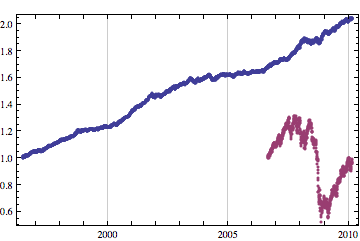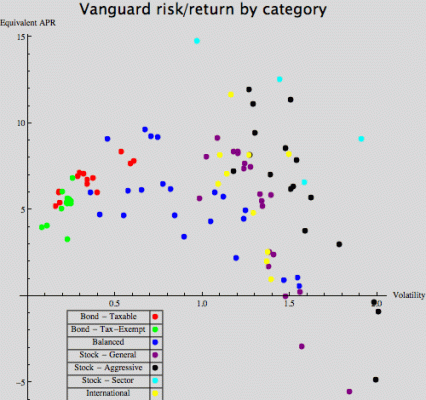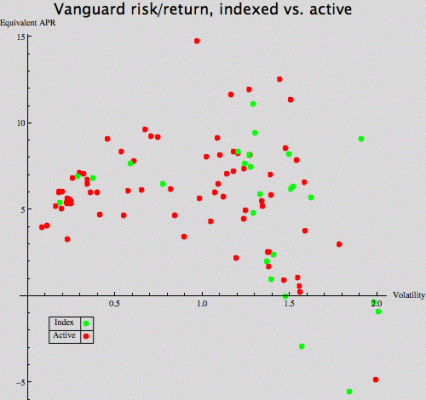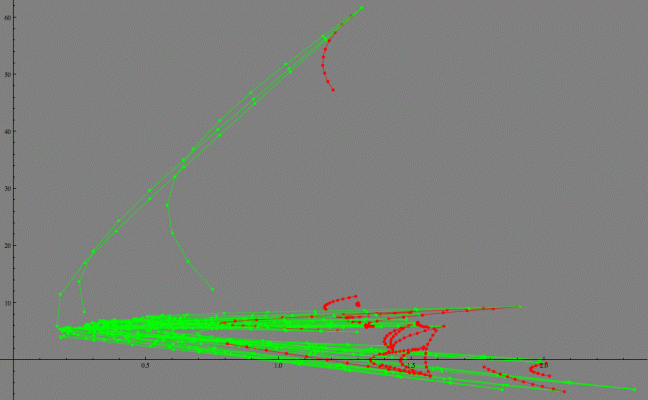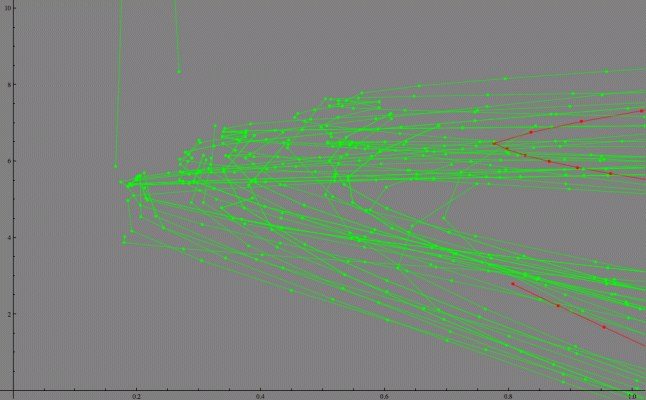IndependentlyPoor
Thinks s/he gets paid by the post
Well, I've been at it again.
The chart below shows return of Vanguard funds vs their volatility. It is kinda/sorta shows the efficient frontier for these funds. The data points are color coded by Vanguard's fund categories.
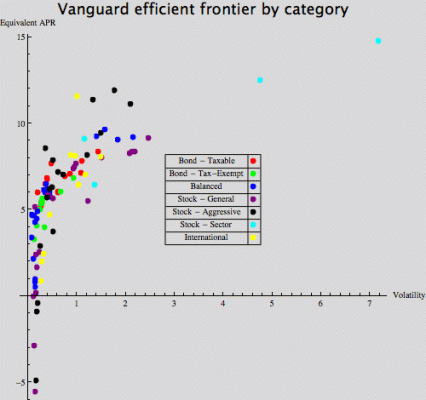
Here is a look at the indexed vs. actively managed funds
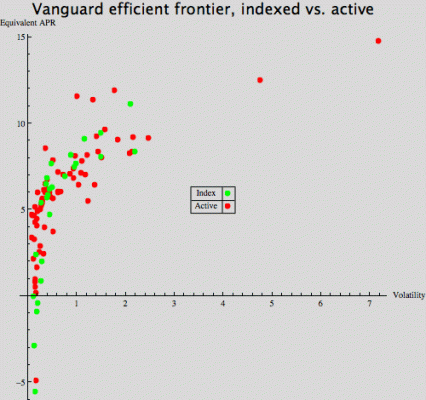
Here is a PDF of of the data, organized by return.
View attachment Vanguard Efficient Frontier by return.pdf
and here is the same data, organized by fund category
View attachment Vanguard Efficient Frontier by category.pdf
You can download an interactive version of the category chart. The interactive versions show the fund name in a little popup when you hover the cursor over a datapoint. Very cool. Here is the link:
http://www.wolfram.com/solutions/in...43&filename=Vanguard+Efficient+Frontier+I.nbp
The bad news is, to use these you have to download a player (sort of like a PDF viewer). The good news is that it is free, and easy to install and use. Here is the link:
Wolfram Mathematica Player: Download
Details:
1. I did not include money market funds because the Mathematica data server doesn't have them.
2. I did not include funds which have less than three years of data available. This avoids extreme results caused by starting the series at just the best or worst time relative to the recent crash and recovery. NOTE: the Mathematica server does not have data going all the way back to inception for some funds, so some funds do not appear even though their inception date is more than three years ago.
3. I calculated the equivalent APR using the standard formula and the total return of the funds at the first and last dates.
4. I normalized the prices of each fund by dividing each daily price by the first price in the fund's series. This puts the standard deviations on more or less an even footing regardless of the NAV.
Usual warning:
I cannot guarantee the accuracy of this information, or even that it makes sense. Do not base investment decisions on this information without independent confirmation.
The chart below shows return of Vanguard funds vs their volatility. It is kinda/sorta shows the efficient frontier for these funds. The data points are color coded by Vanguard's fund categories.

Here is a look at the indexed vs. actively managed funds

Here is a PDF of of the data, organized by return.
View attachment Vanguard Efficient Frontier by return.pdf
and here is the same data, organized by fund category
View attachment Vanguard Efficient Frontier by category.pdf
You can download an interactive version of the category chart. The interactive versions show the fund name in a little popup when you hover the cursor over a datapoint. Very cool. Here is the link:
http://www.wolfram.com/solutions/in...43&filename=Vanguard+Efficient+Frontier+I.nbp
The bad news is, to use these you have to download a player (sort of like a PDF viewer). The good news is that it is free, and easy to install and use. Here is the link:
Wolfram Mathematica Player: Download
Details:
1. I did not include money market funds because the Mathematica data server doesn't have them.
2. I did not include funds which have less than three years of data available. This avoids extreme results caused by starting the series at just the best or worst time relative to the recent crash and recovery. NOTE: the Mathematica server does not have data going all the way back to inception for some funds, so some funds do not appear even though their inception date is more than three years ago.
3. I calculated the equivalent APR using the standard formula and the total return of the funds at the first and last dates.
4. I normalized the prices of each fund by dividing each daily price by the first price in the fund's series. This puts the standard deviations on more or less an even footing regardless of the NAV.
Usual warning:
I cannot guarantee the accuracy of this information, or even that it makes sense. Do not base investment decisions on this information without independent confirmation.
Last edited:

